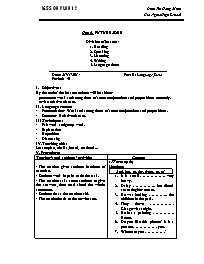Giáo án Tiếng Anh Lớp 12 - Unit 6: Future jobs - Period 40: Language focus - Năm học 2014-2015 - Đinh Thị Hồng Minh

I. Objectives:
By the end of the lesson students will be able to:
+ pronounce weak and strong form of some conjunctions and prepositions correctly.
+ revise relative clauses.
II. Language content
- Pronunciation: Weak and strong forms of some conjunctions and prepositions.
- Structure: Relative clauses.
III. Techniques:
- Pair work and group work.
- Explanation
- Repetition
- Discussing
IV. Teaching aids:
Lesson plan, chalks, board, textbook.
V. Procedure:
Bạn đang xem tài liệu "Giáo án Tiếng Anh Lớp 12 - Unit 6: Future jobs - Period 40: Language focus - Năm học 2014-2015 - Đinh Thị Hồng Minh", để tải tài liệu gốc về máy bạn click vào nút DOWNLOAD ở trên
Unit 6: FUTURE JOBS Division of lessons: 1. Reading 2. Speaking 3. Listening 4. Writing 5. Language focus ___________________________________________________________ Date: 21/11/2014 Part E: Language focus Period: 40 Objectives: By the end of the lesson students will be able to: + pronounce weak and strong form of some conjunctions and prepositions correctly. + revise relative clauses. Language content Pronunciation: Weak and strong forms of some conjunctions and prepositions. Structure: Relative clauses. Techniques: Pair work and group work. Explanation Repetition Discussing Teaching aids: Lesson plan, chalks, board, textbook... V. Procedure: Teacher’s and students’ activities Content - The teacher gives students handouts of exercise. - Students work in pairs to do the task. - The teacher asks some students to give the answers, then read aloud the whole sentences. - Students do as the teacher said. - The teacher leads to the new lesson. - The teacher tells students strong form and weak form of conjunctions and prepositions. - The teacher reads these words and asks students to repeat. - Students listen and repeat. - The teacher asks some students to read aloud these words again. - Some students read aloud these words again. - The teacher gives feedbacks. - The teacher asks students some question. - Students answer teacher’s question. - The teacher lead to the English grammar in the new lesson. - The teacher recall some memorable points about conditional sentences. - Students listen and take notes. - The teacher asks students to work in pairs to do the task. - Students do the task with their partners. - The teacher asks some students to go to the board to write down the answers. - Some students go to the board and write down the answers. - The teacher checks the answers. - Students look at the board, listen and take notes. - The teacher asks students to work in pairs to do the task. - Students do the task with their partners. - The teacher asks some students to go to the board to write down the answers. - Some students go to the board and write down the answers. - The teacher checks the answers. - Students look at the board, listen and take notes. 1.Warm up (6) Handout: And, but, at, for, from, to, of It is small . very heavy. Daisy .. her friend are eating ice- cream. He was looking .. the children in the park. They drove Glasgow last night. He has a painting . Rome. Do you like this picture? It is a present you. Where are you ? 2. Language focus * Activity 1: Practise Pronunciation (6) * Activity 2: Teaching grammar (16) Relative clauses: Relative pronouns: Who Whom Which That Whose Relative clauses: Definite relative clause Non- definite relative clause Omission of relative pronouns Relative pronouns following prepositions. The way to join 2 sentences using relative pronouns. Reducing relative clauses: - To- infinitive - V-ing - V3/V-ed * Activity 3: Exercise 1 (7): Add who, whoever, whose, whom or which to complete the following sentences. 1. whom 2. Which 3. whoever 4. Which 5. which 6. Who 7. whose 8. Who 9. which 10. Whom * Activity 4: Exercise 2 (10): Join the following sentences in 2 ways 1. I read the book which was written by a friend of mine I read the book written by a friend of mine. 2. A man who was carrying a lot of money in a box got on the bus A man carrying a lot of money in a box got on the bus. . VI. Comments
Tài liệu đính kèm:
 giao_an_tieng_anh_lop_12_unit_6_future_jobs_period_40_langua.doc
giao_an_tieng_anh_lop_12_unit_6_future_jobs_period_40_langua.doc





